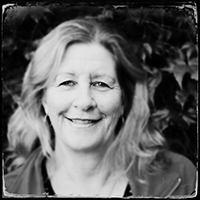How I Became an Instructional Designer: Lyn
In the last few years I’ve noticed an increase in the number of questions that I’ve been asked by visitors to Arizona State University about the Instructional Designers on our team, Instructional Design & New Media, in EdPlus. People want to know about their backgrounds and academic credentials, how we find them, how we hire them, how they work as a team, how they manage their workloads, and more. It occurred to me as I answered these questions that there is a lot I don’t know about how the Instructional Designers in our group arrived at their jobs. I decided to interview some of the team to find out more about the paths they’ve taken to get here. Along the way, I was fortunate enough to have access to some of our colleagues at King’s College, London, with whom we work as part of the PLuS Alliance. In the end, I was able to interview six Instructional Designers from ASU and three from King’s College. During a six month secondment in Sydney, Australia, Renee Pilbeam, an Instructional Designer, Sr. on our team, was able to interview three colleagues from our other PLuS partner, University of New South Wales.
The following includes highlights, pivotal life moments, and milestones that came out in the conversations. One post in the series will be published here at the TeachOnline website each week for three weeks.
Lyn – Sydney – Australia
I was born and raised in Tasmania, one of the states of Australia, and you might know it from the Looney Tunes character, Taz Devil. We feel like we get left behind a bit down there because they sometimes leave Tasmania off the map. The population of Tasmania is about half a million, and Hobart, the capital city, probably has half that population.
I grew up in one of the outlying suburbs of Hobart but moved north to pursue my university degree. There are two universities, one north and one south, and the campus’ divide the courses so that they don’t all repeat. The teaching course that I wanted to take wasn’t offered in Hobart as most of the education courses were offered in the north of the state. Tasmania’s education system was different from pretty much the rest of Australia in those days.
When I think back to teaching as a career choice, in hindsight, I probably should have chosen a different domain. I was so shy, so it was crazy that I went into teaching, really. It’s turned out all right, though, but it was a struggle there for a while.
When I left year 12, I went out to work for a year as a secretary for a lawyer in a government department. These days they would call that a “gap year.” I had no idea what my career path was going to be when I finished year 12. I just focused on the subjects I was best at and thought, “I’ll either be a secretary, or I’ll teach secretarial subjects.” And that was really just a product of not having parents who could advise me — neither of them went to university — and there was also a lack of career advice in those days. Students were just left to fend for themselves and work it out.
Working as a secretary for the lawyer was a good job. For some reason, I felt compelled to go on to uni after working there for 12 months. I don’t know what was driving me really, because I didn’t know anybody else doing that. In the end, I chose commerce teaching, which at the time in Tasmania, was essentially training to teach shorthand and typing. That was a new course at university and as part of that training, we completed about two thirds of a Bachelor degree in Business.
I’m the second youngest of five children. I think I was the first in my family to go to university full-time. One of my brothers was studying for a degree part-time and working. My older brother worked and then did uni part-time later. Like most “firsts” in any family, I struggled a bit at uni, but I finished, did my preps, and completed my degree.
Then I took a job teaching at a senior secondary college. I absolutely loved the teaching there, but only taught shorthand and typing for two years before it was dropped as a subject because everything was becoming digitized and there were dictaphones. Taking shorthand was no longer a required skill for the business world. I continued to teach business subjects, though, until I had my first child, and then I basically resigned because of the struggles of coming back part-time.
After I resigned from the secondary college and moved back to Hobart with my young family, the principal at a school there reached out to me. He knew that I wanted to stay at home to raise my child, but he also knew that I liked teaching. Senior secondary schools were delivering distance education at that time as well as face-to-face classes. Because Tasmania has such a low population, it only has a certain number of education centers — it’s a bit like Outback Australia made up of thousands of acres, so students did school “over the air.” They basically took classes via postal and telephone services.
In Tasmania, materials were mailed out to students, and they worked through a textbook and step-by-step instructions. So the principal in Hobart invited me to teach that way, and I could do it in the evenings. My husband had my daughter at home, so we had good childcare arrangements. I loved that work because it met my family criteria and it was also really nice to work with people who were returning to their studies to better themselves. Some of my students actually chose my classes (I was delivering accounting at that stage) because they couldn’t choose all of the subjects they wanted in their timeline. Therefore, they completed one as distance students, or what we called “rural students,” because they lived a long way from school. These distance classes enabled them to travel to school fewer days per week. I taught that way for quite a few years.
The work was relatively easy because the students were self-motivated. I remember one year, I had a student who, with hardly any help from me, earned the top mark at the school, after the exam and the assessments were compiled. That was a very rewarding moment.
I probably entered the online world shortly after that time. Just before I left Tasmania, I trained to put all of that content I was delivering by printed booklet, online. Learning management systems had just come into being, and I was training to input all of that content and learning activities online. Then, as part of my employment, I had to complete a training and assessments certificate. The experience led me back to just loving learning again and thinking about teaching. I applied for a job at Macquarie University in 2009 as an online educational designer. It was a bit of a fluke that they offered me the job, but it was the early days in Sydney for using LMSs and supporting academics. My teaching background, my distance education experience, and the recent training and assessments certificate, ensured I was qualified enough to earn the position. So I’ve been working in higher ed in an educational developer role since 2009, both at Macquarie University and now at University of New South Wales.
My first manager was an amazing mentor, and he actually helped me get the job at Macquarie University. When I went into distance education, he just kept me under his wing to guide me all that time. Moving into higher ed, I happened to land under an amazing boss, who was an incredibly innovative and visionary person and wonderful to work for.
I study fully online now, and I’m really glad I started this program. It has helped me quite a bit in terms of reminding me of learning theories, principles, and frameworks. We do get asked often, “Where is your evidence for that?” or “Why do you say groups should be this sort of size or a video should be this sort of length?” So it is really good to keep up with the latest theories and ideas. There’s nothing like being a student yourself to help you think about what students need when you’re supporting academics. It really works quite well, and I’m not that far off from finishing my Master’s degree online.
Back in 1991, I traveled for a year. My husband and I were both teachers, and we had taken what’s called a “long-service leave.” So after ten years of service, we received three months paid leave. This was before we had children, so we extended that to take twelve months off. We purchased an around-the-world ticket and spent three months in South America, three months in North America, about three months in Europe, and a few months in the Middle East, Egypt, Greece, the Greek Islands, and Jordan. Having a year off work was a fabulous window, and it was an amazing opportunity to see the world. We took all our bushwalking gear and hiked on pretty much every continent. That was a focus, to just do lots and lots of hiking.
We had wonderful experiences through that life-changing world travel, but going to university was my greatest life-changing event.
Renee: What’s one piece of advice you would give your 18-year-old self?
That’s a really, really hard one. I would say, keep an open mind about career options, and seek advice about potential careers. It wasn’t until I started teaching that I found my strengths were in people management and organizational behavior. Not long into my teaching, I was given a special role as many changes began taking place at the school. I was put in place to help communicate those changes and help support people through it. I really, really enjoyed it, and the experience proved pivotal to later opportunities. This experience really opened up as a result of being mentored by the right person. Seeking out an appropriate mentor is an important step in a rewarding career.
Additional editing: Debra Sims




